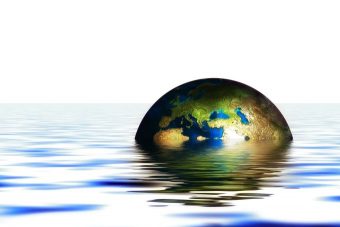
The rate at which sea level rise is occurring is continuing to increase every year, according to a new study that was published in the journal the Proceedings of the National Academy of Sciences.
To be more exact here — the new research found that sea level rise is now (as determined by 25 years of analyzed satellite data) increasing by a rate of 0.08 mm/year every year. If such a rate of increase were to continue it would mean that average world sea levels would rise by 10 mm/year or more by 2100.
The reality is that the rate of sea level rise could increase vastly more than that by 2100, presuming that nonlinear changes to the West Antarctic and Greenland ice sheets were to occur by then, which at this point more or less seems to be a given.
What the new research is saying is that at current rates of increase, sea levels will rise by more than 65 cm (26 inches) by 2100. That presumes no nonlinear changes to the idea sheets of Greenland and West Antarctica, as noted above.
What seems most likely at this point, based on a look back at the records of earlier periods of such warming is that there will be catastrophic sea level rise pulses of some intensity of other within the next 50 or so years. Some of these may well see sea levels rise by as much as 5-10 feet over a period of just a few years.
The geography of Greenland, for instance, is at this point a sort of bowl with perforated edges…and holes in the bottom…filled with ice… assuming nothing but linear change will occur to the Greenland ice sheet when one considers this.
As explained by lead researcher Steve Nerem, a professor of Aerospace Engineering Sciences at the University of Colorado Boulder and CIRES Fellow: “This acceleration, driven mainly by accelerated melting in Greenland and Antarctica, has the potential to double the total sea level rise by 2100 as compared to projections that assume a constant rate — to more than 60 cm instead of about 30. And this is almost certainly a conservative estimate. Our extrapolation assumes that sea level continues to change in the future as it has over the last 25 years. Given the large changes we are seeing in the ice sheets today, that’s not likely.”
In other words, even if sea level rise was to “only” continue accelerating at current rates rather than to vastly speed up over the coming years, as it actually is going to, sea levels would still rise enough by the end of the century to effectively end sea-based international trade in much of the world. It would also be enough to set off truly enormous mass migrations of various peoples across long distances, which would directly trigger warfare and societal collapse on a scale not seen in a long, long time in any regions, and pretty much never on the global scale.
Those that want to comprehend what is coming may want to remember that 2,500 years ago there were no Germanic or Slavic peoples in Europe; 4,000 years ago there were no Celtic peoples in Europe; etc. Much of what is unreflectively assumed to be “truth” in the world is just a matter of collective psychological comfort, more than anything else. Many of these “truths” bring with them deadly blind spots.
It may well be time for many continental “Europeans” to deal with the actual history of the place and the actions of their ancestors, and to comprehend the real reasons that the peoples that reside there now look, speak, and behave, very different from the “Europeans” of just a few thousand years ago. A closer look at the so-called Northern Crusades would also likely be of value to those wanting to better comprehend the skeletons in the closet…and likely futures.
What point am I making here? That big changes are coming, and that a more realistic understanding of what constitutes “truth” to collectives of peoples would likely be of value to many of those reading this. Comfortable long-held assumptions — whether of the “liberal” or “conservative” sorts (neither of which seem to actually exist in any real way in politics anymore) — are likely to be a death sentence, as they both seem to be based largely on inherited, unexamined untruths.
As a side note here — the mass migrations that are due to begin over the coming decades (no, they haven’t truly begun yet — what’s occurred to date is a trickle, to be followed by a deluge) are extremely unlikely to be stopped to any real degree by efforts occurring on a national or continental scale, despite what modern egos may like to say. That’s simply not what history shows.
So, to say it one last time: If you want to know what’s going to happen, then you should try to understand what has actually happened in the past, as the past is the foundation of everything that now exists.
Source: cleantechnica.com



